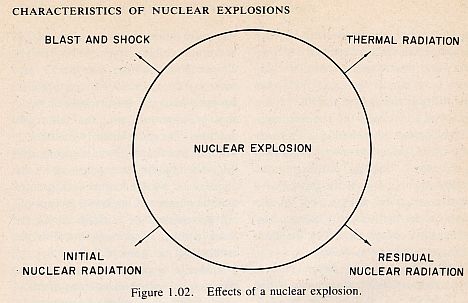 |
Finally the substances remaining after a nuclear explosion are radioactive, emitting similar radiations over an extended period of time. This is known as the "residual nuclear radiation" or "residual radioactivity" /Fig. 1.02). 1.03 It is because of these fundamental differences between a nuclear and a conventional explosion, including the tremendously greater power of the former, that the effects of nuclear weapons require special consideration. In this connection, knowledge and understanding of the mechanical and the various radiation phenomena associated with a nuclear explosion are of vital importance. 1.19 A distinction has sometimes been made between atomic weapons, in which the energy arises from fission, on the one hand, or hydrogen (or thermonuclear) weapons, involving fusion, on the other hand. In each case, however, the explosive energy results from nuclear reactions, so that they are both correctly described as nuclear weapons. In this book, therefore, the general terms "nuclear bomb" and "nuclear weapon" will be used, irrespective of the type of nuclear reaction producing the energy of the explosion. |
1.20 The "yield" of a nuclear weapon is the measure of the amount of explosive energy it can produce. It is the usual practice to state the yield in terms of the quantity of TNT that would generate the same amount of energy when it explodes. Thus, 1 1-kiloton nuclear weapon is one which produces the same amount of energy in an explosion as does a 1 kiloton ( or 1,000 tons) of TNT. Similarly, a 1-megaton weapon would have an energy equivalent of 1million tons (or 1,000 kilotons) of TNT. The earliest nuclear bombs, such as were dropped over Japan in 1945and used in the tests at Bikini in 1946, released very roughly the same quantity of energy as 20,000 tons (or 20 kilotons) of TNT (se, however, § 2.24). Since that time, much more powerful weapons, with energy in the megaton range, have been developed.
1.21 From the statement in § 1.15 that the fission of 1 pound of uranium or plutonium will release the same amount of explosive energy as about 8,000 tons of TNT, it is evident that in a 20-kiloton nuclear weapon 2.5 pounds of material undergo fission. However the actual weight of uranium or plutonium in such a weapon is greater that this amount. In other words, in a fission weapon, only part of the nuclear material suffers fission. The efficiency is thus said to be less than 100 percent. The material that has not undergone fission remains in the weapon residues after the explosion.